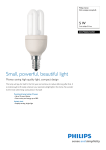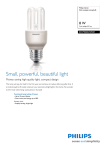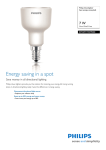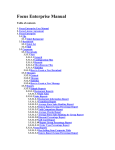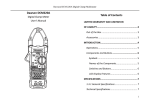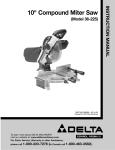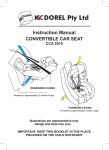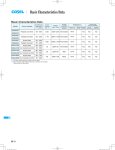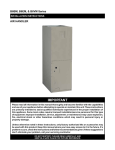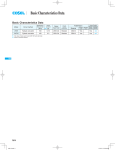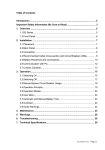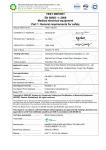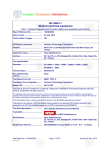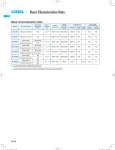Download Basic characteristics data • Instruction manual
Transcript
Basic Characteristics Data Basic Characteristics Data Model GHA300F GHA500F GHA500F-SNF Circuit method Switching frequency [kHz] boost chopper 60 - 220 LLC resonant converters 90 - 180 boost chopper 60 - 220 LLC resonant converters 90 - 180 boost chopper 60 - 220 LLC resonant converters 90 - 180 Inrush current protection Material 3.3 Thermistor FR-4 5.4 Thermistor Aluminum/FR-4 5.4 Thermistor Aluminum/FR-4 Input current *1 [A] *1 The value of input current is at ACIN 120V and rated load. *2 Parallel operation is available with –P option. Refer to 5.1on the instruction manual. GHA GHA-8 Series/Parallel operation availability PCB/Pattern Single Double sided sided Series operation Parallel operation Yes Yes No Yes Yes Yes *2 Yes Yes Yes *2 AC-DC Power Supplies Medical Type Instruction Manual 1 2 3 Function GHA-10 1.1 Input voltage range GHA-10 1.2 Inrush current limiting GHA-10 1.3 Overcurrent protection GHA-10 1.4 Overvoltage protection GHA-10 1.5 Thermal protection GHA-10 1.6 Output voltage adjustment range GHA-10 1.7 Output ripple and ripple noise GHA-10 1.8 Isolation GHA-11 Series Operation and Parallel Operation GHA-11 2.1 Series Operation GHA-11 2.2 Parallel Operation GHA-11 Assembling and Installation Method GHA-11 3.1 Heat dissipation (derating) GHA-12 3.2 Installation method GHA-13 3.3 Mounting screw GHA-14 3.4 Expectancy life and warranty GHA-14 3.5 Extermal capcitor on the output side GHA-14 4 Ground GHA-14 5 Option and Others GHA-15 5.1 Outline of options GHA-15 5.2 Medical Isolation Grade GHA-17 5.3 Others GHA-17 GHA GHA-9 AC-DC Power Supplies Medical Type Instruction Manual Remarks : 1 Function Please avoid applying a voltage exceeding the rated voltage to an output terminal. Doing so may cause a power supply to malfunction or fail. If you cannot avoid doing so, for example, if you need 1.1 Input voltage range to operate a motor, etc., please install an external diode on the ¡The range is from AC85V to AC264V or DC130V to DC370V (please see SPECIFICATIONS for details). ¡In cases that conform with safety standard, input voltage range is AC100-AC240V (50/60Hz). (a) Recommended Capacity : 6.3A, slow -blow DCIN FUSE L N Fig.1.1 Connection method ¡If input value doesn’t fall within above range, a unit may not operate in accordance with speci cations and/or start hunting or fail. If you need to apply a square waveform input voltage, which is commonly used in UPS and inverters, please contact us. ¡When the input voltage changes suddenly, the output voltage accuracy might exceed the speci cation. Please contact us. 1.2 Inrush current limiting ¡An inrush current limiting circuit is built-in. ¡If you need to use a switch on the input side, please select one that can withstand an input inrush current. ¡Thermistor is used in the inrush current limiting circuit. When you turn the power ON/OFF repeatedly within a short period of time, please have enough intervals so that a power supply cools down output terminal to protect the unit. 1.5 Thermal protection ¡Over Temperature Protection (OTP) is built in. ¡If this function is in operation, turn off power, eliminate all possible causes of overheating, and drop the temperature to nomal level. Output voltage recovers after applying input voltage. The recovery time varies depending on input voltage and load condition. 1Over rated temperature 2Poor ventilation 3Over peak load based on Instruction Manual 4. for Peak loading Remarks : Please comply with recommended mounting method in section 3.1. 1.6 Output voltage adjustment range ¡To increase an output voltage, turn a built-in potentiometeris clockwise. To decrease the output voltage, turn it counterclockwise 1.7 Output ripple and ripple noise ¡Output ripple noise may be in uenced by measurement environment, measuring method Fig.1.2 is recommended. +Vout before being turned on. C1 ¡Surge current in the lter unit does not include. (0.2ms or less). -Vout 1.3 Overcurrent protection cally recovers when a fault condition is removed. Differential probe Please do not use a unit in short circuit and/or under an overcur- C1 : Film capacitor 0.1μF rent condition. C2 : Aluminum electrolytic capacitor 22μF ¡Intermittent Operation Mode Intermittent operation for overcurrent protection is included in a part of series. When the overcurrent protection circuit is activated and the output voltage drops to a certain extent, the output becomes intermittent so that the average current will also decrease. 1.4 Overvoltage protection Load 150mm Osiloscope/ Ripple noise meter Bw:20MHz ¡An overcurrent protection circuit is built-in and activated at 105% of the rated current or 101% of the peak current. A unit automati- GHA C2 + Fig.1.2 Measuring method of Ripple and Ripple Noise Remarks : When GND cable of probe with ux of magnetic force from power supply are crossing, ripple and ripple noise might not measure correctly. Please note the measuring environment. ¡An overvoltage protection circuit is built-in. If the overvoltage protection circuit is activated, shut down the input voltage, wait more than 3 minutes and turn on the AC input again to recover the output voltage. Recovery time varies depending on such factors as input voltage value at the time of the operation. Bad example GHA-10 Good example Fig.1.3 Example of measuring output ripple and ripple noise Instruction Manual AC-DC Power Supplies Medical Type 1.8 Isolation ¡For a receiving inspection, such as Hi-Pot test, gradually increase (decrease) the voltage for the start (shut down). Avoid using HiPot tester with the timer because it may generate voltage a few times higher than the applied voltage, at ON/OFF of a timer. ¡When you test a unit for isolation between the input and output, input and the terminal FG or between the output and the terminal FG, short-circuit between the output and the terminals RCG, PGG and AUXG. 2 Series Operation and Parallel Operation ¡Even a slight difference in output voltage can affect the balance between the values of I1 and I2. Please make sure that the value of I3 does not exceed the rated current of a power supply. I3 [ the rated current value Please evaluate carefuly and test for any possible failure modes. ¡Hot-swap or Hot-plug is not available. 3 Assembling and Installation Method ¡Features of the cooling method ¿ GHA500F ¡Cooling method Conduction cooling, forced air and convection cooling are avail- 2.1 Series Operation ¡Series operation is available by connecting the outputs of two or more power supplies with the same output voltage, as shown below. Output current in series connection should be lower than the able. The combination of the cooling method makes mechanical design exible. lowest rated current in each unit. Remarks : Please be sure to have enough cooling in case one of the power Power + Supply - 6) conduction cooling + forced air (Variable speed FAN) Load Load Power + Supply - : Heat dissipation Load Power + Supply - : chassis FAN supply stops due to activation of the protection circuitry. Power + Supply - Combination Fig.2.1 Examples of connecting in series operation Seal case FAN 2.2 Parallel Operation ¡Parallel operation Parallel operation is possible with option ”-P”. Parallel operation is not available for the standard unit, please refer to the listed options. ¡Redundancy operation Redundancy operation is available by wiring as shown below. Power + Supply - I1 I2 2) conduction cooling Combination 3) forced air Combination I3 Load Power + Supply - 1) convection Fig.2.2 Example of redundancy operation 4) convection + conduction cooling 5) conduction cooling + forced air Fig.3.1 Cooling method Combination In order to determine if the power supply operates according to our speci cations, the maximum operating temperature and temperature measuring points are shown in table 3.1., for reference. GHA-11 GHA AC-DC Power Supplies Medical Type Instruction Manual ¿ GHA300F Remarks: ¡Cooling method Both Forced air and convection cooling are available. the power supply is used by the sealing up space as showing in There is a possibility that it is not possible to cool enough when Fig.3.3. (Fig 3.1 1),3),6)cooling method). Remarks: Chassis ¡For proper operation of the power supply, please note the following: 1Heat dissipation (derating):Section 3.1 reference -The temperature rise and heat dissipation of the converter must be Power supply Fig.3.3 Installation example considered. -Conditions varies with environment and input voltage. -Mounting surface will be very hot during the operation ,so please ¿ GHA500F be careful not to touch the surface. (A) - (F) mounting (*) 100 2Insulation distance: Please refer to Section 3.2 -AC voltage exist on the primary side therefore. insolation distance. 3.1 Heat dissipation (derating) 80 Load factor [%] -In order to prevent electric shock, or to meet the leakage current requirements of the safety standard, you need to ensure the proper 60 40 20 ¡Given the potential for variation between one application and another, the real test is to measure the critical components temperature 0 -20 rise when the power supply installed in the end-application. -10 0 For reliable and safe operation, please make sure the maximum component temperatures rise given in table 3.1 is not exceeded. 500 Power [W] expectancy. The actual life expectancy can be extended by reduc- 2 3 4 450 400 350 Please contact us for more detail. 1 70 550 Operating at the maximum temperature rating results in 3-Years life ¡Test Measuring points Be aware of the conductive parts during the measurements. 60 *Maximum power with Forced air (Fig.3.5) ent cooling methods. information. 50 Fig.3.4 Forced air cooling derating curve (Reference value) Please refer to Fig.3.4 - 3.9 for derating information based on differ- ing the ambient temperature. Please refer to section 3.4 for more 10 20 30 40 Ambient temperature [C] 5 8 6 7 0 GHA MADE IN JAPAN 0 2.0 2.5 3.0 3.5 4.0 Wind velocity [m/s] Fig.3.5 The maximum output power by wind speed conditions 100 (b)Lower substrate Fig.3.2 Temperature measurement points locations Table 3.1 Maximum operating temperature GHA Point Parts name Symbol No. 1 2 3 4 5 6 7 8 Line Filter Varistor Input Capacitor Output Capacitor Rectifier Transformer Output Choke Aluminum base plate L101 SK101 C106 C506 SS11 T11 L51 - Maximum temperature[C] 500F 300F 115 115 76 76 89 89 87 87 120 120 110 110 115 115 * Remarks 75 (C),(D),(E) mounting (A) mounting 50 (B) mounting (Pomax:150W) 25 (F) mounting 0 -20 case temperature *Operating ambient temperature derating of Conduction cooling (Reference value) GHA-12 Load factor [%] (a)Upper substrate -10 0 10 20 30 40 Ambient temperature [C] 50 60 70 Fig.3.6 Convection cooling derating curve (Reference value) Instruction Manual AC-DC Power Supplies Medical Type Load factor [%] 100 75 ¡Mounting method (B) (A) (Pomax:360W) (C) CN101 (A) - (F) mounting CN101 50 CN101 Standard Position 25 CN101 0 -20 -10 0 10 20 30 40 50 60 70 (D) (E) (F) 80 Aluminum base plate temperature [C] CN101 Fig.3.7 Conduction cooling derating curve (Reference value) CN101 ¿ GHA300F 100 Fig.3.11 Mounting method (A) - (F) mounting (Pomax:300W) 3.2 Installation method Load factor [%] 80 ¡During use, keep the distance between d1 & d2 for to insulate between lead of component and metal chassis, use the spacer of 60 5mm or more between d1. If it is less than d1 & d2, insert the insu- 40 lation sheet between power supply and metal chassis. 20 0 -20 ¿ GHA500F -10 0 10 20 30 40 Ambient temperature [C] 50 60 70 5mm min Fig.3.8 Forced air cooling derating curve (Reference value) Component side 100 Load factor [%] 75 (B),(C) mounting (D),(E) mounting d1 50 (Pomax:100W) d1 d1 25 (A) mounting 0 -20 -10 0 d1 10 20 30 40 Ambient temperature [C] 50 60 d1=4mm min 70 Fig.3.9 Convection cooling derating curve (Reference value) Fig.3.12 Installation method ¿ GHA300F ¡Input voltage derating curve Derating curve depending on input voltage is Fig.3.10. 5mm min For maximum power in each cooling method, please apply. Component side 100 d2=5mmmin Load factor [%] 90 80 d1 70 d1 GHA d1 60 0 90 115 Input Voltage [V] Fig.3.10 Input voltage derating curve d1 d1=4mm min Fig.3.13 Installation method GHA-13 AC-DC Power Supplies Medical Type 3.3 Mounting screw ¡Warranty ¡The mounting screw should be M3. The hatched area shows the allowance of metal parts for mounting. ¿ GHA300F, GHA500F 8 Instruction Manual 8 8 8 CN101 Table 3.4 Warranty (GHA500F-O) Cooling Method Mounting Method Average ambient temperature (year) Ta = 35C or less A, C, D Ta = 40C B Ta = 45C Convection Ta = 30C or less E Ta = 35C F Ta = 30C Ta = 40C or less Forced air A,B,C,D,E,F Ta = 50C Warranty Io[75% 75%<Io[100% 5years 5years 5years 3years 5years 5years 5years 5years 5years 4years 5years 5years 5years 4years 5years 3years Table 3.5 Warranty (GHA300F-O) 8 8 8 8 Unit [mm] Fig.3.14 Allowance of metal for mounting ¡If metallic ttings are used on the component side of the board, ensure there is no contact with surface mounted components. ¡This product uses SMD technology. Please avoid the PCB installation method which includes the twisting stress or the bending stress. 3.4 Expectancy life and warranty ¡Expectancy Life. Table 3.2 Life Expectancy (GHA500F-O) Cooling Method Mounting Method Average ambient temperature (year) Ta = 35C or less A, C, D Ta = 40C B Ta = 45C Convection Ta = 30C or less E Ta = 35C F Ta = 30C Ta = 40C or less Forced air A,B,C,D,E,F Ta = 50C Expectancy Life Io[75% 75%<Io[100% 10years 6years 7years 4years 10years 7years 10years 7years 7years 5years 10years 7years Over 10years Over 10years Over 10years Over 10years Table 3.3 Life Expectancy (GHA300F-O) Cooling Method Mounting Method A B, C D Convection Average ambient temperature (year) Ta = 30C Ta = 45C Ta = 45C Ta = 40C or less E Ta = 45C Ta = 40C or less Forced air A,B,C,D,E,F Ta = 50C Expectancy Life Io[75% 75%<Io[100% Over 10years Over 10years Over 10years 7years Over 10years Over 10years Over 10years 7years Over 10years 6years Over 10years Over 10years Over 10years Over 10years Cooling Method Mounting Method A B, C D Convection Average ambient temperature (year) Ta = 30C Ta = 45C Ta = 45C Ta = 40C or less E Ta = 45C Ta = 40C or less Forced air A,B,C,D,E,F Ta = 50C Warranty Io[75% 75%<Io[100% 5years 5years 5years 5years 5years 5years 5years 5years 5years 4years 5years 4years 5years 3years *Warranty with conduction cooling is three years at the highest point of the temperature measurement. 3.5 Extermal capcitor on the output side ¡When the load currnet changes rapidly, for output stability improvement, we recommend that you connect the capacitor to the output terminal. Tabel 3.6 External capacity on the output recommended capacity [μF] GHA300F-12 GHA500F-12 GHA500F-15 GHA300F-24 GHA500F-24 GHA500F-30 GHA300F-48 GHA500F-48 GHA500F-56 Output Voltage [V] Recommended capacity [μF] 10.8[Vo[13.2 2,200 to 22,000 13.5[Vo[16.5 2,200 to 10,000 21.6[Vo[26.4 3,300 to 8,800 27.0[Vo[31.5 43.2[Vo<51.0 51.0[Vo[52.8 52.0[Vo[56.0 3,300 to 8,800 0 to 1,000 0 to 120 0 to 120 Remarks: When load current changes rapidly, some specifications may not meet the spec. Please mount power supply after enough evaluation and comply with recommended amount of capacitor. If you exceed the rated amount of capacitor, output for power supply may be stopped or Remarks: Estimated life expectancy can be calculated by point temperature GHA 3 ,4 shown in section 3.1. Please contact us for details. power supply may be unsteable. 4 Ground ¡In the case of the power installation, please be sure to connect two or more Input FG and mounting hole FG with safety ground of the chassis. GHA-14 Instruction Manual AC-DC Power Supplies Medical Type 5 Option and Others ¡Remote ON/OFF -You can operate the remote ON/OFF function by sending signals to CN501. Please see Table 5.3 for speci cations and Fig.5.2 for connecting examples. 5.1 Outline of option -Remote ON/OFF circuits (RC1 and RCG) are isolated from input, output FG, AUX and PG. ¿ –J1 -Please note the followings when using the remote ON/OFF function. ¡Connector(s) is / are replaced to VH connectors (Mfr. J.S.T.). 1 -R3 turns on by drawing current to RC, –SNF turns off by drawing current to RC. ¿ –R3, –SNF 2The current own to RC is a 5mA typ (maximum 30mA). 3If the output voltage is turned off through the remote ON/OFF ¡The following features are included. ¡Dedicated harness. Please refer to the optional parts. ¡AUX1 (12V±10% –R3 : 1.0A, –SNF : 0.5A) -This power supply is equipped with an axuiliary low power 12V output AUX1 which is available from CN501. -AUX has been isolated from other circuit (input, output, FG, RC, PG). -Do not exceed the current rating, it may causes malfunction or failure of the internal circuitry. ¡AUX2 (5V1A) -Output AUX2 will be generated from CN501. AUX2 (5V±5% 1.0A) can be used to power up remote control or other circuits. AUX has been isolated from other circuit (input, output, FG, RC, PG). circuit, 12V AUX stops. 4If the output voltage is turned off through the remote ON/OFF circuit, PG signals turn to "High". 5If voltage or current of a value not listed in Table 5.3 is applied between RC1 and RCG, the output voltage may not be generated normally. 6Please wire carefully. If you wire wrongly, the internal components of a unit may be damaged. Table 5.3 Speci cations of remote ON/OFF Fig.5.2 RC circuit example Output on SW Logic Output off -Do not exceed the current rating , it may causes malfunction or failure of the internal circuitry. -When the load currnet changes rapidly, for output stability improvement, we recommend that you connect the capacitor to the output terminal. recommended capacity [mF] GHA300/500F 330 ~ 560 5V (AUX2) ¡Alarm -Table 5.2, see Fig 5.1 the internal structure circuit explaining the operation of the PG alarm. Alarm output Open collector method Good : Low(0-0.5V 10mA max) Bad : High or Open(40V 0.5mA max) Tr : 40V 10mA max (3mA min) SW open (0.1mA max) SW close or H-SN-35 (a) (b) AUX2 7 5V 440W 3 RC1 R1 4 RCG 8 AUX2G 7 V1 SW 5V AUX2 440W 3 RC1 4 RCG 8 SW AUX2G CN501 CN501 (Example V1 : 5V R1 : 270W) Table 5.2 Description of the alarm Alarm output condition Or lowering of the rated output voltage, output PG, PGG from terminal when you stop. PG *Output is unstable state when the overcurrent condition –SNF SW open (0.1mA max) (3mA min) H-SN-34 Optional harness Table 5.1 External capacitor on the recommended capacity of AUX2 Output Voltage –R3 SW close Fig.5.2 RC circuit example * If the output of an external power supply is within the range of 4.5 - 12.5V, you do not need a current limiting resistor R1. If the output exceeds 12.5V, however, please connect the current limiting resistor R1. To calculate a current limiting resistance value, please use the following equation. 0.1mF 100kW PG R1[W]= V1-(1.1+RiX0.005) 0.005 Ri=440[W] GHA Tr PGG Fig.5.1 Internal circuit of PG GHA-15 Instruction Manual AC-DC Power Supplies Medical Type ¿ –SNF Expected lifetime [H] 1,000,000 ¡Chassis and a cooling fan are added. ¡Oil and chemical environment may cause of power supply’s malfunction or failure. Please avoid operation and storage in such environments. ¡Derating It should be satis ed that derating curve depending on input volt- 100,000 10,000 age in Fig.3.10 and derating curve on ambient temperature in 20 30 40 50 60 70 80 FAN exhaust temperature [C] Fig.5.4. As the veri cation method, temperature of measurement point A should be rated temperature or less in Table 5.4. Fig.5.5 Expected life time of FAN 20mm FAN 7 1 Measurement point 2 8 Air flow Power supply (Top view) Input Point A Output Fig.5.3 Measurement point A Fig.5.6 Measurement of FAN exhaust temperature Table 5.4 Rated temperature of measurement point A ¡Mounting screw Screw length into power supply should be shorter than 6mm due Ambient temperature 50C 70C 65C or less 78C or less Measurment Point A to keep safety isolation clearance from inside components in Fig.5.7. Please x power supply surely by screws in consideration of the weight. 100 Chassis of customer system Load factor [%] 80 Chassis of power supply 60 40 Screw M4 20 0 -20 6mm max ̂ 0 10 20 30 40 50 60 70 Fig.5.7 Mounting screw Ambient temperature [C] Fig.5.4 Ambient temperature derating curve (Reference) ¡When output current more than rated, output may shut down after 5 seconds or more. Recycle the input after 3 minutes to reset the ¡A cooling FAN is built-in. Please keep 30mm or more clearance both input and output side to make enough air ventilation. Do not block off cooling FAN’s air ow for stable operation. Air flow protection. If load wires are generating heat, intake air temperature may become high. It may in uence to FAN exhaust temperature. It is a notice that optical wires have to be selected for the avoidance. When FAN stop or air volume decrease happen, power supply’s output will be shut down. 30mm or more Input Output (A) GHA-16 Input 30mm or more Output 30mm or more Input Output 30mm or more (B) (C) ¡When power supply is used where dust exist, it may cause of FAN failure. It is recommended to install a air lter to the system air ventilation duct. GHA 30mm or more FAN perature from FAN at input terminal side. Air flow measurement point temperature in Fig.5.6, which exhaust air tem- 30mm or more Air flow ¡Maintenance of FAN FAN life time expectancy (R(t)=90%) in Fig.5.5 is depended on AC-DC Power Supplies Medical Type ¿ –T3 Instruction Manual 5.3 Others ¡M3 threaded mounting hole is available as an option (–T3). : Tap ¡High voltage exist in the power supply for a few minutes after input voltage is stopped. Please pay attention to this during the maintence. ¡Notes for mounting 1All Mounting holes should be tight and secured. Case (a) T3 (Threaded mounting hole) (b) Standard (Through hole) Fig.5.8 Screw mounting image 2Power supply should be mounted parallel to the mounting surface. 3Avoid applying mechanical stress or shock to the power supply. ¡When power supply is energized or immidately after power supply stops working, power supply is still very hot, so please handle it with care. ¿ –P ¡Parallel operation is available (Recommended two). ¡Output wattage setting is 90% per power supply of MAX OUTPUT WATTAGE. Remarks: -The difference of output voltage between power supply for parallel operation should be less 0.1V. -During parallel operation, higher voltage power supply become the master in system. Depend on voltage difference between master and slave, the master power supply may recover the system’s required wattage up to 90% of MAX OUTPUT WATTAGE. The master unit should be evaluated for heat dissipation, life expectancy and warranty period according to section 3.1 - 3.4. -Parallel operation, due to the uctuation of load, the output voltage may be varied. There is a possibility that beat noise occurs due to the difference of the oscillation frequency. Please use after enough evaluation. -Forced air cooling is required. -Input voltage ought be AC115V or more. 5.2 Medical Isolation Grade ¡GHA series t 2MOPP 2MOPP primary secondary 1MOPP Safety GND Fig.5.9 Medical Isolation Grade GHA GHA-17











